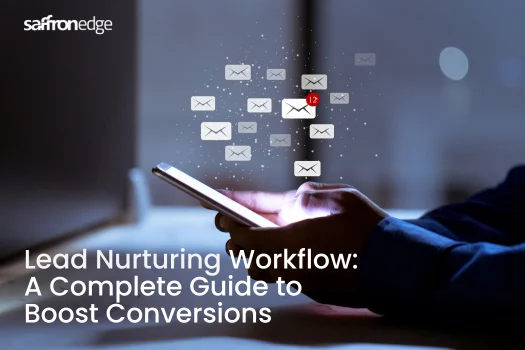Have you ever wondered why some leads become loyal customers while others disappear into the void? What if there was a structured way to engage prospects, guide them through their buyer’s journey, and increase your chances of conversion?
That’s where a lead nurturing HubSpot workflow comes in. It’s not just about sending follow-up emails—it’s about delivering the right message, at the right time, through the right channels. And the numbers prove its effectiveness:
Companies that excel at lead nurturing generate 50% more sales-ready leads at a 33% lower cost. (Barnraisers LLC)
Despite this, many businesses still lack a structured lead nurturing workflow, leading to lost sales opportunities. So, how can you create a system that nurtures leads effectively and drives revenue growth?
In this blog, we’ll break down the key components, steps, and best practices for building a high-converting lead nurturing workflow that keeps your prospects engaged and moving toward a purchase.
What is a Lead Nurturing Workflow?
Lead nurturing is a systematic approach to developing relationships with potential buyers at every stage of their decision-making process. A lead nurturing workflow is an automated sequence of marketing actions designed to engage, educate, and convert potential customers over time.
It typically includes personalized emails, follow-up messages, and targeted content based on user behavior, interests, and position in the sales funnel. These workflows, such as HubSpot lead nurturing workflow, help businesses systematically guide leads through the buying journey by delivering relevant information at the right time. By leveraging automation, lead nurturing workflows ensure consistent communication, improve engagement, and increase conversion rates while reducing manual effort.
The Importance of Lead Nurturing Email Workflow
A well-structured lead nurturing workflow helps businesses build trust, educate prospects, and guide them smoothly through the sales funnel.
By automating this process, companies can improve conversion rates while maintaining meaningful interactions with potential customers. Here’s why lead nurturing workflows are essential:
-
Builds Stronger Relationships: Lead nurturing workflows allow businesses to engage prospects at various touchpoints, strengthening relationships and ensuring that leads feel valued throughout their journey.
-
Increases Conversion Rates: Effective lead nurturing maximizes the value of your marketing efforts, leading to higher conversion rates.
-
Enhances Personalization: With automation and behavioral tracking, workflows can send personalized messages based on user interactions, improving engagement and response rates.
-
Saves Time & Resources: Automating lead nurturing reduces manual follow-ups, allowing sales and marketing teams to focus on high-intent prospects and strategic growth initiatives.
-
Shortens the Sales Cycle: Providing timely, relevant content addresses objections and accelerates decision-making, helping leads move through the funnel faster.
-
Boosts Customer Retention: Lead nurturing isn’t just for new leads; it also helps maintain relationships with existing customers, driving repeat business and brand loyalty.
-
Increased Sales-Ready Leads: Companies that excel at lead nurturing generate 50% more sales-ready leads at a 33% lower cost.
Investing in lead nurturing isn’t just a strategy—it’s necessary for sustainable growth in today’s competitive landscape.
5 Key Factors of B2B Lead Nurturing Workflows
Effective B2B lead nurturing workflows ensure that prospects receive timely, relevant, personalized communication throughout their buyer journey. These workflows help businesses engage leads, build trust, and convert them into paying customers. To maximize success, consider these key factors:
1. Segmentation
Not all leads are the same—some are just beginning their research, while others are ready to purchase. Segmentation allows businesses to divide leads into distinct groups based on various criteria, ensuring that communication is relevant and personalized.
How to Segment Leads Effectively
-
Demographics: Segment leads based on age, location, job title, company size, or industry.
-
Behavioral Data: Group leads based on their actions, such as website visits, email engagement, content downloads, and ad interactions.
-
Stage in the Buyer’s Journey: Classify leads into Awareness, Consideration, and Decision stages, delivering content that matches their level of interest.
-
Source of Lead Acquisition: Leads coming from different channels (organic search, paid ads, social media, events, referrals) may require tailored nurturing strategies.
2. Content Mapping
Once leads are segmented, content mapping ensures they receive information relevant to their stage in the sales funnel. Sending generic messages can lead to disengagement, so businesses must align their content with where the lead is in their journey.
Content for Each Stage of the Buyer’s Journey
Awareness Stage (Top of Funnel – TOFU)
-
Goal: Educate and introduce the brand.
-
Best Content Types: Blog posts, infographics, industry reports, social media content, educational videos.
-
Example: A lead searching for "how to improve email marketing" might receive a beginner’s guide to email marketing.
Consideration Stage (Middle of Funnel – MOFU)
-
Goal: Help leads compare solutions and address pain points.
-
Best Content Types: Webinars, product comparison guides, whitepapers, case studies.
-
Example: A lead who downloaded an email marketing guide might now receive a case study on how a company improved email conversion rates by 30%.
Decision Stage (Bottom of Funnel – BOFU)
-
Goal: Encourage purchase decisions with compelling proof.
-
Best Content Types: Testimonials, product demos, free trials, discount offers, and sales consultations.
-
Example: A lead who attended a webinar may receive an exclusive offer for a free software trial or a one-on-one sales consultation.
3. Multi-Channel Approach
Modern buyers engage with brands across multiple touchpoints. Relying on one channel (e.g., email only) limits your ability to reach and nurture leads effectively. A multi-channel approach ensures your message is seen on platforms where your leads are most active.
Key Channels for Lead Nurturing
-
Email Marketing: Personalized email sequences based on user behavior.
-
Social Media: Retargeting ads, LinkedIn outreach, and social proof.
-
Webinars & Live Events: Interactive sessions to educate and build trust.
-
SMS & Chatbots: Personalized engagement with quick responses.
-
Paid Advertising: Retargeting ads to keep your brand top-of-mind.
4. Automation
Manually managing lead nurturing can be overwhelming. Marketing automation tools (such as HubSpot, Marketo, Pardot, or ActiveCampaign) allow businesses to automate workflows, send personalized content, and track engagement without requiring constant manual intervention.
How Automation Enhances Lead Nurturing
-
Trigger-Based Email Sequences: Automatically send emails based on user actions (e.g., downloading an ebook, visiting a pricing page).
-
Behavior Tracking: Monitor website visits, email engagement, and social media interactions to tailor future communications.
-
CRM Integration: Sync data with sales teams to ensure personalized follow-ups.
-
Lead Retargeting: Use AI to show relevant ads based on user interests.
5. Lead Scoring
Not all leads are equally likely to convert. Lead scoring assigns numerical values to leads based on their engagement and interactions, helping businesses focus on the most promising prospects.
How Lead Scoring Works
Positive Actions (Increase Score):
-
Downloading a whitepaper (+10)
-
Opening an email (+5)
-
Attending a webinar (+15)
-
Requesting a demo (+20)
Negative Actions (Decrease Score):
-
Unsubscribing from emails (-10)
-
Inactive for 60+ days (-15)
Once a lead reaches a predetermined score (e.g., 50 points), they are considered sales-qualified and transferred to the sales team for direct outreach.
Get Higher Conversions with Automated Lead Nurturing
Struggling with lead drop-offs? Engage prospects with targeted emails, timely follow-ups, and data-driven automation. Turn cold leads into loyal customers to supercharge your lead nurturing now!
How to Create a Lead Nurturing Workflow?
Follow a well-defined process to ensure your lead nurturing workflow is structured and results-driven. Here’s a breakdown of the essential steps:
-
Define Your Goals: Clearly outline what you aim to achieve with your lead nurturing efforts, such as increasing conversion rates or shortening the sales cycle.
-
Identify Your Audience: Understand your leads' names, pain points, and locations in the buyer's journey.
-
Develop Relevant Content: Create content that addresses the specific needs of each segment and stage. This could include blog posts, whitepapers, videos, or case studies.
-
Set Up Automation: Use marketing automation platforms to deliver content based on triggers such as website visits, content downloads, or email opens.
-
Monitor and Optimize: Regularly analyze the performance of your workflows. Use metrics such as open rates, click-through rates, and conversion rates to identify areas for improvement.
4 Best Practices for Lead Nurturing
These practices enhance lead nurturing by making interactions more personalized, timely, consistent, and educational. Implementing these strategies helps build trust, engage leads, and increase conversion rates effectively.
1. Personalization
Personalization helps create a more engaging experience by addressing leads by name and tailoring content based on their interests and behavior.
Dynamic email content, personalized product recommendations, and targeted messaging improve engagement. Businesses that leverage personalization see higher conversion rates and customer loyalty.
2. Consistency
Maintaining a uniform brand voice and messaging across all communication channels builds trust and brand recognition.
Whether through emails, social media, or ads, consistency ensures that leads receive a cohesive experience. This reduces confusion and increases the chances of conversion.
3. Timeliness
Engaging leads at the right moment keeps them interested and prevents lost opportunities. Automated triggers, such as follow-up emails after content downloads or chatbots for instant responses, ensure quick interactions.
Prompt responses to lead actions show attentiveness and improve customer experience.
4. Educational Content
Providing valuable content that informs and educates leads positions your brand as an industry expert.
Blog posts, case studies, webinars, and whitepapers help leads make informed decisions. Businesses can build trust and nurture leads effectively by offering insights and solutions.
How to Overcome Challenges in Lead Nurturing?
While lead nurturing is essential for driving conversions, businesses often face challenges that can hinder its effectiveness. Here are some common obstacles and how to manage them:
-
Content Overload: Sending too much content frequently can overwhelm leads, leading to disengagement. To avoid this, focus on delivering the right content at the right time, ensuring it aligns with the lead’s interests and stage in the buyer’s journey.
-
Data Management: Maintaining accurate and up-to-date lead information is crucial for effective personalization. Implementing CRM systems and automation tools helps manage, update, and segment lead data, ensuring more relevant communication.
-
Alignment Between Marketing and Sales: Disconnection between marketing and sales teams can result in inconsistent messaging and lost opportunities. Establish clear communication, shared goals, and lead qualification criteria to ensure both teams work towards a unified strategy.
-
Low Engagement Rates: If leads aren’t opening emails or interacting with content, it may indicate a lack of relevance. Use A/B testing, segmentation, and personalization to refine your messaging and deliver content that resonates with your audience.
-
Measuring Effectiveness: Tracking the success of lead nurturing efforts can be complex without the right metrics. Monitor key performance indicators (KPIs) like open rates, click-through rates, and conversion rates to assess what’s working and make data-driven improvements.
Conclusion
A well-structured lead nurturing workflow helps businesses build stronger relationships, engage prospects effectively, and drive conversions.
By following best practices and addressing common challenges, companies can create a seamless journey for their leads.
However, managing an efficient lead nurturing process requires the right tools and expertise.
Saffron Edge specializes in marketing automation services, helping businesses implement data-driven strategies, personalized campaigns, and seamless workflows to maximize conversions. Contact Saffron Edge today to optimize your lead nurturing strategy and accelerate growth!
Get The Marketing Automation Toolkit
Frequently Asked Questions
What is a lead nurturing workflow?
A lead nurturing workflow is a strategic process that guides potential customers through the sales funnel using personalized content, automated follow-ups, and targeted messaging. It helps businesses engage leads, build relationships, and increase conversions efficiently.
Why is lead nurturing important for businesses?
Lead nurturing ensures prospects receive the right information at the right time, keeping them engaged and moving them toward a purchase decision. It helps improve customer trust, shortens sales cycles, and increases ROI by converting more leads into paying customers.
How can automation improve lead nurturing?
Automation streamlines lead nurturing by sending timely and relevant messages based on user actions, saving time and ensuring consistent communication. It enables businesses to segment audiences, personalize content, and track lead interactions for better engagement.
What type of content is best for lead nurturing?
Effective lead nurturing content includes educational blog posts, case studies, whitepapers, webinars, and personalized emails. The key is to provide value at each stage of the buyer’s journey, helping leads make informed decisions.
How do you measure the success of a lead nurturing workflow?
Success is measured through key performance indicators (KPIs) like email open rates, click-through rates, lead engagement, and conversion rates. Analyzing these metrics helps businesses refine their approach and improve overall lead nurturing effectiveness.
Related Blogs
We explore and publish the latest & most underrated content before it becomes a trend.

Subscribe to Saffron Edge Newsletter!

Get The Marketing Automation Toolkit










